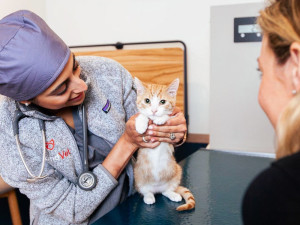An Oregon Resident Just Caught the Bubonic Plague, Likely From Their Cat
Here is everything pet parents need to know.
A cat parent in central Oregon has been diagnosed with bubonic plague (yes, you read that right), which they reportedly got from their symptomatic cat, per a statementopens in new tab from health officials on the Deschutes County website. The statement reads that the illness was caught early, “posing little risk to the community.” There have been no other cases identified in the investigation.
“All close contacts of the resident and their pet have been contacted and provided medication to prevent illness,” said Dr. Richard Fawcett, Deschutes county health officer, in the statement.
Check out customizable policies from our friends at Lemonade Pet Insurance—so you only pay for what you need.
Bubonic plague symptoms and how to stay safe
The plague is a zoonotic disease, meaning humans can catch it from animals. Per Deschutes County, symptoms in humans usually occur about two to eight days after they’re exposed to an animal or flea that has the disease. These can include: “sudden onset of fever, nausea, weakness, chills, muscle aches, and/or visibly swollen lymph nodes called buboes.” In the statement, Oregon Health Authority confirmed that the last case of this plague in Oregon was in 2015.
Health officials advise for pet parents to take the following steps to protect themselves from this rare illness:
How much do you spend on your pet per year?
Keep all pets on leash outdoors and treat them with flea prevention.
Don’t let your pet come into contact with wild rodents (including while hunting).
Never touch dead rodents or fleas.
Don’t feed any of these animals.
Wear long pants while outside to avoid contact with fleas.
Don’t camp near areas where dead rodents have been spotted.
The history of the plague in the U.S. and how to treat it
Per the Centers for Disease Control (opens in new tab CDC), the plague was first introduced to the U.S. in 1900 by rat-infested steamships. “The last urban plague epidemic in the United States occurred in Los Angeles from 1924 through 1925,” the CDC sites statesopens in new tab. Plague then spread from urban rats to rural rodent species, and became entrenched in many areas of the western United States. Since that time, plague has occurred as scattered cases in rural areas.”
The CDC statesopens in new tab that the plague is serious but usually treatable with antibiotics for seven to 14 days. The organization continues with a warning: “If you live or have recently traveled to the western U.S. or any other plague endemic area and have symptoms suggestive of plague, seek health care immediately.”










